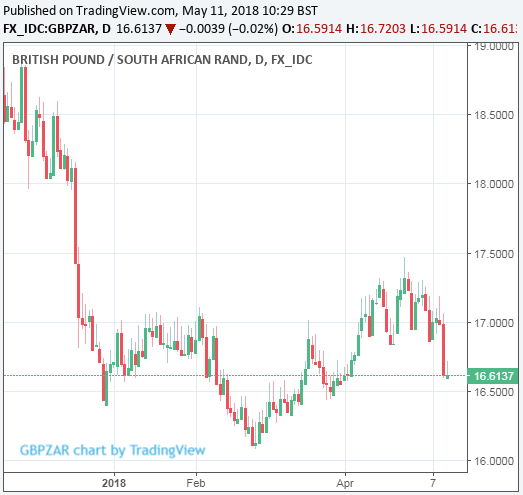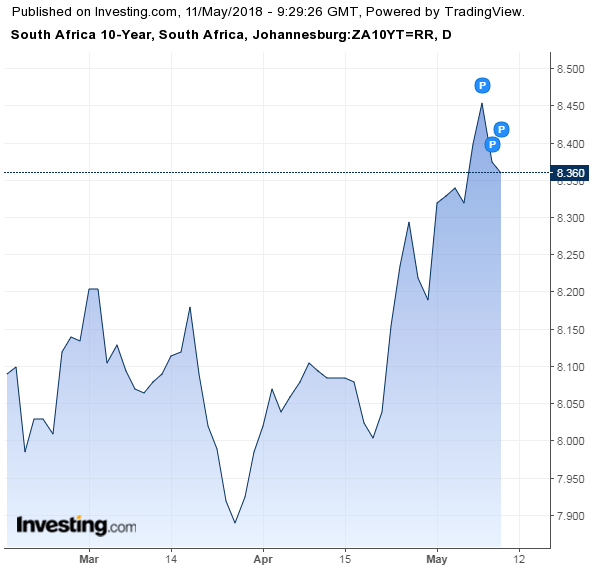South African Rand Catches a Break on US Dollar Withdrawal, Analysts say It has Further to Run
- Written by: James Skinner
-
- ZAR stabilises, holding onto large gains from Thurday.
- US Dollar rally likely over now say ING, positive for ZAR.
- ZAR to benefit from yield support, equity inflows say BofAML.

© Rawpixel.com, Adobe Stock
The South African Rand looks to lock-in recent gains against a host of currencies ahead of the weekend as it holds the powerful advance registered on Thursday, May 11.
The emerging-market currency advanced amidst a broad dissipation of recent US Dollar strength, and analysts now say the currency and its emerging-market compatriots could be due a further recovery during the days and weeks ahead.
South Africa's currency has fallen more than 3% against the US Dollar in the last month alone and now trades at a loss for the 2018 year-to-date and also carries a fractional loss against Pound Sterling, despite all of the British unit's recent weakness.
This is while emerging market stocks and bond markets saw their largest outflows of cash since December 2016 when the US Dollar was also rising sharply in response to the election of President Donald Trump.
A sharp rise in American bond yields, a stronger greenback and rising oil prices have put pressure on the Rand and other emerging market currencies in recent weeks.

Above: 10 Year US Government Bond Yields have surged and provided the USD support amidst ongoing strength in the US economy.
Concerning the outlook, what matters most for the developing world's exchange rate complex now is whether the strong-Dollar trend continues during the weeks ahead. Some analysts say the Dollar's best days have been and gone.
"There are some tentative signs that the storm of Dollar buying might have blown itself out. Some of the high yield EM currencies most under pressure recorded sizable gains on Thursday after the core US CPI figure rose a benign 0.1% MoM in April. The biggest potential dollar positive risk of the week has therefore been negotiated," says Chris Turner, global head of FX strategy at ING Group.
While the strong-Dollar trend began to ebb on Wednesday it wasn't until after Thursday's US inflation figures were released that emerging market currencies were able to stage a meaningful riposte of the greenback's recent assault.
US inflation rose slower than was expected during the April month, taking some of the upward pressure off of American bond yields and tempering speculation the Federal Reserve could be forced into a faster pace of interest rate rises later this year. This is of course a positive development for currencies like the Rand.
"Clearly EM investors are hoping (and praying) that the dollar rally is nearly over, but as long as EM growth rates hold up and dollar rates don’t have another discrete 25bp move higher, we think positive investment trends will dominate. Being dollar bears, we think there is a chance that DXY put in an important high at 93.42 on Wednesday and we would now favour a tentative decline to 92.00," Turner adds.

Above: USD/ZAR rate shown at daily intervals.
The USD/ZAR rate was quoted 0.03% higher at 12.31 during the morning session Friday while the Pound-to-Rand rate was 0.09% higher at 16.64 after steep losses of more than 1% on Thursday.
The Rand traded around 0.1% lower against all other developed world currencies.

Above: Pound-to-Rand rate shown at daily intervals.
"In South Africa, both positioning data and price action suggests the market is long rates but likely lightened up in FX, as the Rand moved weaker in line with the traditional USD beta despite the supportive country story," says Claudio Irigoyen, a rates strategist at Bank of America Merrill Lynch. "Relatively high real rates, low inflation pass-through, a steep curve and favorable supply dynamics could maintain South African Government Bonds' bid should the USD stabilize."
Irigoyen and the BAML FX team say the Rand's recent weakness could provide investors with an ideal opportunity to pick up more South African government bonds on the cheap and that this is likely because of the high "real yield" offered by them. If true, this would be positive for the Rand during the days and weeks ahead.

Above: South African 10 Year Government Bond Yield.
South Africa's 10 year government bond yield was at 8.36% during the morning session on Friday but the country's inflation rate is just 3.8%. This means South African 10 year bonds offer investors a "real return" of almost 5%, which more than can be said for almost all other stable emerging markets and certainly the entire developed world bond complex.
Irigoyen also says, in a note this week, that international investors are still holding very light positions in South African stocks despite a positive economic backdrop in the country, which could benefit the Rand if equity investors decide to increase their exposure to the South African stock market. This might be likely now the US Dollar has stabilised.
Advertisement
Get up to 5% more foreign exchange by using a specialist provider to get closer to the real market rate and avoid the gaping spreads charged by your bank when providing currency. Learn more here.





